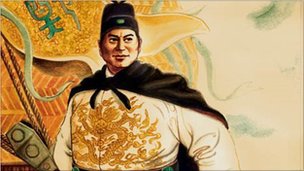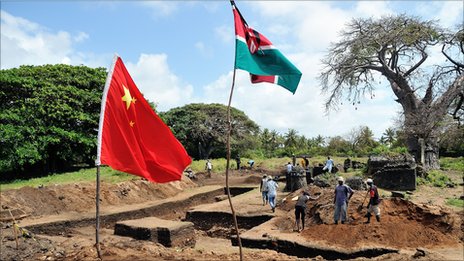Peking University, Oct. 18, 2010: Prof. Qin Dashu shows off some of his finds and said: “It is not much to look at - a small pitted brass coin with a square hole in the center - but this relatively innocuous piece of metal is revolutionizing our understanding of early East African history, and recasting China's more contemporary role in the region.”

"This is a wonderful and very important piece,”said Prof. Qin Dashu of Peking University
A joint team of Kenyan and Chinese archaeologists found the 15th Century Chinese coin in Mambrui - a tiny, nondescript village just north of Malindi on Kenya's north coast.
In barely distinguishable relief, the team leader Prof. Qin Dashu from PKU School of Archaeology and Museology, read out the inscription: "Yongle Tongbao" - the name of the reign that minted the coin some time between 1403 and 1424.
"These coins were carried only by envoys of the emperor, Chengzu," Prof. Qin said.
"We know that smugglers would often take them and melt them down to make other brass implements, but it is more likely that this came here with someone who gave it as a gift from the emperor."
And that poses the question that has excited both historians and politicians: How did a coin from the early 1400s get to East Africa, almost 100 years before the first Europeans reached the region?
When China ruled the seas
The answer seems to be with Zheng He, also known as Cheng Ho - a legendary Chinese admiral who, the stories say, led a vast fleet of between 200 and 300 ships across the Indian Ocean in 1418.
Until recently, there have only been folk tales and insubstantial hints at how far Zheng He might have sailed.

It is now believed that China's Zheng He reached East Africa long before any European explorer
Then, a few years ago, fishermen off the northern Kenyan port town of Lamu hauled up 15th Century Chinese vases in their nets, and the Chinese authorities ran DNA tests on a number of villagers who claimed Chinese ancestry.
The tests seemed to confirm what the villagers have always believed - that a ship from Zheng He's fleet sank in a storm and the surviving crew married locals, meaning some people in the area still have subtly Chinese features.
Searching for clues
It was then that Peking University organized its expedition to try to find conclusive evidence. The university is spending $3 million (£2 million) on the three-year project.

The dig suggests China's interest, not ambition, in Africa goes back a long way
Prof. Qin's team chose to dig in Mambrui for two reasons.
First, ancient texts told of Zheng He's visit to the Sultan of Malindi - the most powerful coastal ruler of the time. But they also mentioned that Malindi was by a river mouth; something that the present town of Malindi doesn't have, but that Mambrui does.
The old cemetery in Mambrui also has a famous circular tomb-stone embedded with 400-year-old Chinese porcelain bowls hinting at the region's long-standing relationship with the East.
In the broad L-shaped trench that the team dug on the edge of the cemetery, they began finding what they were looking for.
First, they uncovered the remains of an iron smelter and iron slag.
Then, Mohamed Mchuria, a coastal archaeologist from the National Museums of Kenya, unearthed a stunning fragment of porcelain that Prof. Qin believes came from a famous kiln called Long Quan that made porcelain exclusively for the royal family in the early Ming Dynasty.
The jade-green shard appears to be from the base of a much larger bowl, with two small fish in relief, swimming just below the surface of the glaze.
"This is a wonderful and very important piece, and that is why we believe it could have come with an imperial envoy like Zheng He," Prof. Qin said.

The team is hoping to unearth more buried secrets
Re-writing history?
While the evidence is still not conclusive, it undermines Portuguese explorer Vasco Da Gama's claim to have been the first international trader to open up East Africa.
He arrived in 1499 on an expedition to find a sea route to Asia, and launched more than 450 years of colonial domination by European maritime powers.
"We're discovering that the Chinese had a very different approach from the Europeans to East Africa," said Herman Kiriama, the lead archaeologist from the National Museums of Kenya.
"Because they came with gifts from the emperor, it shows they saw us as equals. It shows that Kenya was already a dynamic trading power with strong links to the outside world long before the Portuguese arrived," he said.
And that is profoundly influencing the way Kenya is thinking about its current ties to the East.
It implies that China has a much older trade relationship with the region than Europe, and that Beijing's very modern drive to open up trade with Africa may in fact be part of a far deeper tradition than anyone suspected.
In 2008 China's trade with the continent was worth $107bn (£67bn) - more even than the United States, and 10 times what it was in 2000.
"A long time ago, the East African coast looked East and not West," said Mr Kiriama.
"And maybe that's why it also gives politicians a reason to say: 'Let's look East' because we've been looking that way throughout the ages."
Reported by: Peter Greste (BBC East Africa correspondent, Mambrui, Kenya)
Edited by: Su Juan
Source: BBC News